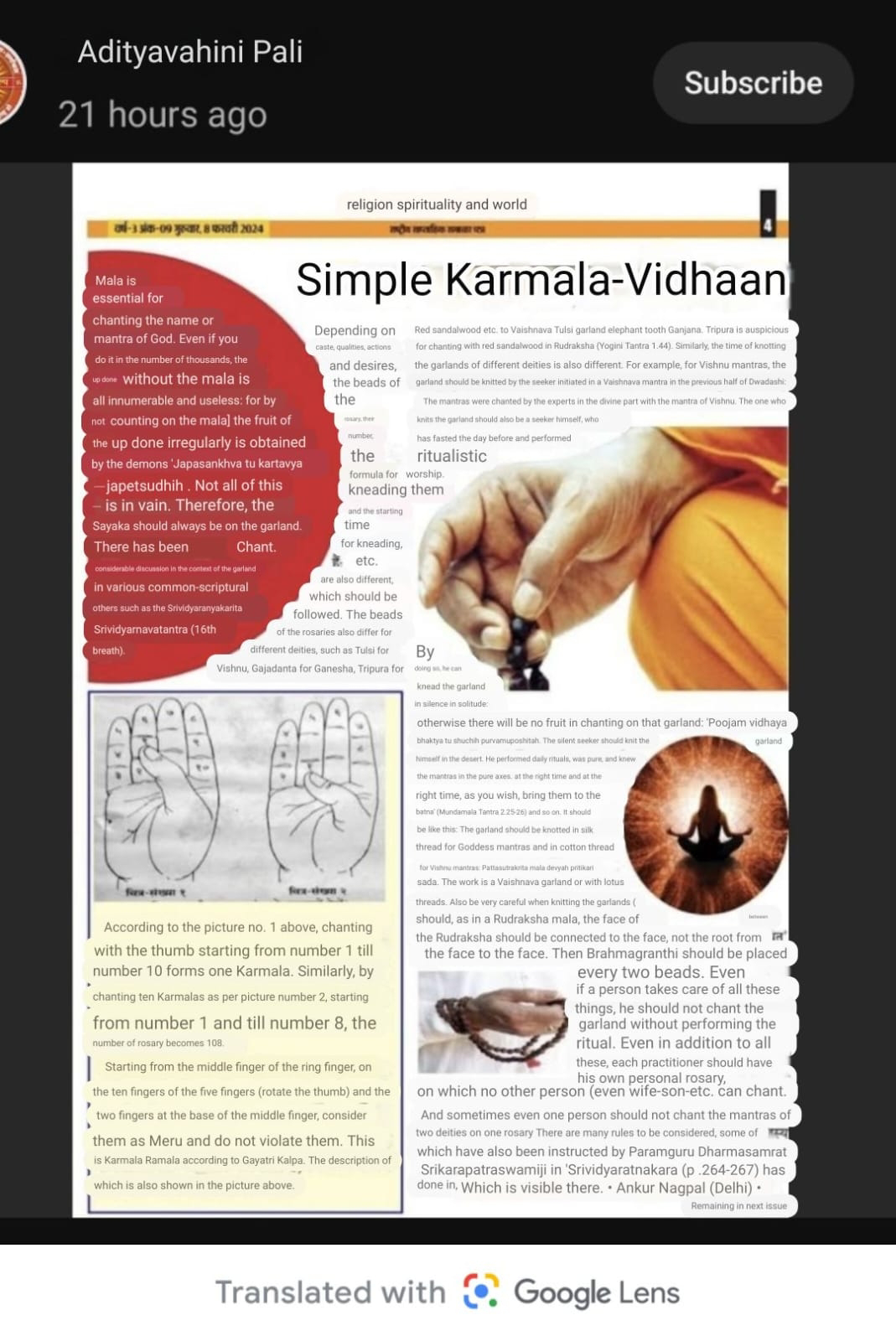Mala is essential for chanting the name or mantra of God. Even if you do it in thousands, the chanting done without the beads is entirely innumerable and fruitRed sandalwood etc. to Vaishnava Tulsi garland with elephant teeth to Gajanana. Tripurava is auspicious for chanting with red sandalwood in Rudraksha (Yogini Tantra 1.44). Likewise; The time for knotting the beads of different deities also varies. For example, for Vishnu mantras, on the morning of Dwadashi, a seeker initiated in a Vaishnava mantra should knead the garland: By chanting the mantra-knowing Vishnu mantra in the divine part with great effort. The one who knits the garland should also be a seeker himself, who has fasted the day before and performed ritualisticless: because (by not counting on the beads] the fruit of the chanting done irregularly is obtained by the demons: 'Japasankhya tu kartavya nasankhyatam Therefore, the seeker should always chant on the garland. There has been enough discussion in the context of the garland in various Agama-scriptural others such as Sri Vidyaranyakritha Sri Vidyarnavatantra (16th)
Depending on caste, qualities, actions and desires, the beads of the rosary, their number, the formula for kneading them and the starting time for kneading, etc. are also different, which should be followed. The beads of the garlands also differ for different deities, Tulsi for Vishnu, Gajdant for Ganesha, Tripura for Red sandalwood etc. to Vaishnava Tulsi garland with elephant teeth to Gajanana. Tripurava is auspicious for chanting with red sandalwood in Rudraksha (Yogini Tantra 1.44). Likewise; The time for knotting the beads of different deities also varies. For example, for Vishnu mantras, on the morning of Dwadashi, a seeker initiated in a Vaishnava mantra should knead the garland: By chanting the mantra-knowing Vishnu mantra in the divine part with great effort. The one who knits the garland should also be a seeker himself, who has fasted the day before and performed ritualistic By doing so, he can knead the garland in silence in solitude: otherwise there will be no fruit in chanting on that garland: 'Poojam vidhaya bhaktya tu shuchih purvamuposhitah. The seeker should knot the garland in silence in the solitude. He performed daily rituals, was pure, and knew the mantras in pure minds. at the right time and at the right time, as you wish, bring them to the batna' (Mundamala Tantra 2.25-26) and so on. Similarly: The garland should be woven into silk thread for Goddess mantras and into cotton thread for Vishnu mantras: 'Pattasutrakrita mala devyah pritikari sada. A garland of cotton or Vaishnava or with lotus threads. One should also take great care when knitting the beads, such as the face to face of the Rudraksha in a Rudraksha mala
It should be added, not from the mouth, to the root, mukhe mukh tu dhyakti, mukhe moolam tu varjayet (Mundamala Tantra 2.32). Then outer gland should be placed between every two beads. Even if a person takes care of all these things, he should not chant the rosary without performing the rituals. Apart from all this, every seeker should have his own personal rosary, on which no other person (including wife, son, etc.) can chant. And in some cases only one person cannot chant the mantras of two deities on one rosary. Generally, with a few exceptions, chanting of Devi Mantras is prohibited on the Rudraksha rosary: 'Rudraksh: Shaktimantram Cha Mantri Yah Prajpetipraye. Sa Durgatimvapnoti Nishphalastasya Tanjapah. There are many such rules for consideration, some of which have been instructed by Paramguru Dharmasamrat Srikarpatraswamiji also in 'Srividyaratnakar'. (Page 264-267) • Remainder
Has done, which is visible there. • Ankur Nagpal (Delhi)
in the next issue
According to the picture no. 1 above, chanting with the thumb starting from number 1 till number 10 forms one Karmala. Similarly, by chanting ten Karmalas as per picture number 2, starting from number 1 and till number 8, the number of rosary becomes 108.
Starting from the middle finger of the ring finger, on the ten fingers of the five fingers (rotate the thumb) and the two fingers at the root of the middle finger, consider them as Meru and do not violate it. This is Karmala according to Gayatri Kalpa, the description of which is also shown in the above picture.


No comments:
Post a Comment